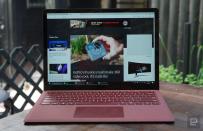The Surface Laptop is the pinnacle of design
But Windows 10 S is still too limited for most.
Just a few years ago, the idea that Microsoft could be one of the most exciting PC makers around would have seemed insane. The first Surface didn't inspire much hope. (I distinctly remember wanting to throw it out of a window during my review). But, like any wise newcomer, Microsoft learned and improved with every new Surface. The year 2015 was when it all came together, with the excellent Surface Pro 4 and Surface Book. (That the upcoming Surface Pro looks almost exactly like its predecessor is a testament to great design.) And earlier this year, we got the Surface Studio, a unique attempt at reinventing the all-in-one PC.
With all of that innovation, the idea of a traditional Surface notebook seems, well, a bit boring. But the Surface Laptop is anything but. It might not have the flashy features of its siblings, but it's far more focused on one thing: being a great notebook. Not everyone wants a hip hybrid tablet. Many people just want a portable, well-built and powerful machine with great battery life for getting all of their work done. In that respect, the Surface Laptop delivers in spades. The only problem? It's powered by Windows 10 S, Microsoft's more restrictive OS meant for schools, which could end up frustrating plenty of consumers.
Hardware
Strangely enough, the Surface Laptop looks like the evolution of the MacBook Air's design that we've been waiting for. It doesn't go for extreme portability like the tiny MacBook; instead it streamlines what we've come to expect from 13-inch ultraportables. At 2.8 pounds, the Surface Laptop weighs 0.2 pounds less than the Air. It's not a huge difference, but it's a noticeable one. And unlike LG's ultralight Gram, it feels solid, and has no sign of flexing around its frame.
As you'd expect, the Surface Laptop echoes the design of its siblings. It has a smooth aluminum case (which is a big reason why it feels so sturdy), and it shares the rounded edges and clean lines of other Surface PCs. But of course, there's no kickstand or unique hinge this time around. The only noticeable feature, aside from the silver Microsoft logo, is the air vents on its rear. If Microsoft was aiming to mimic the sophisticated minimalism typically associated with Apple, it succeeded.
While the Surface Laptop doesn't sport ultrathin screen bezels like Dell's XPS line, its 13.5-inch display is generous. You also won't find any speaker grilles on this laptop -- instead the sound comes directly through the keyboard. It's a bit odd at first, especially since you can feel vibrations as your fingers rest on the keys, but the speaker placement makes for a far better audio experience than you'd find on most laptops. The sound is enveloping and detailed, and there's even a bit of low end too. It's ideal for video watching, since it comes right at you. In comparison, other laptops have speakers off to the sides, or beneath the screen, which projects sound away from you.
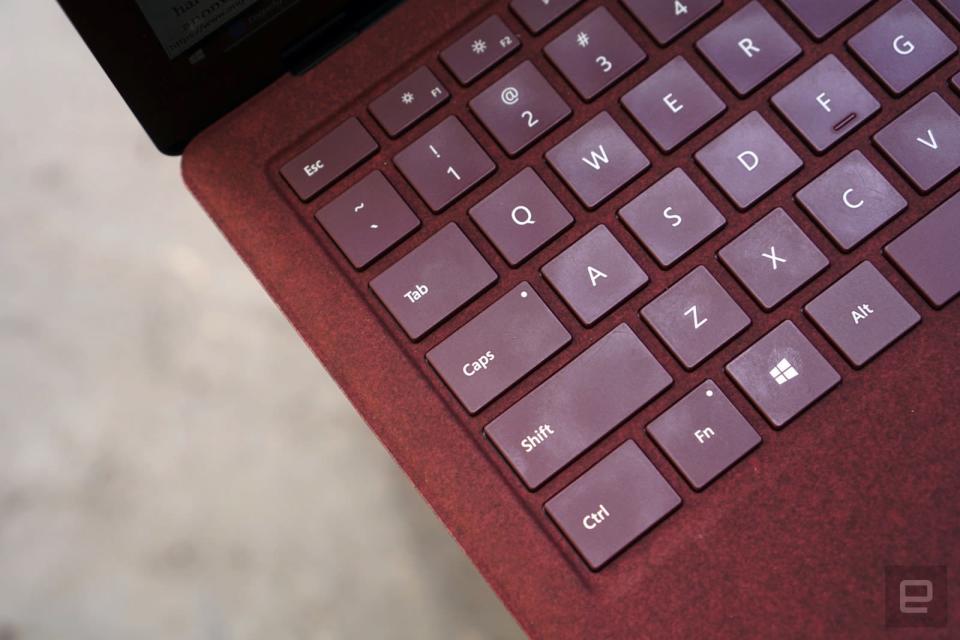
Speaking of the keyboard, it's the most unique design element of the Surface Laptop. It's covered in Alcantara, a microfiber material that's typically found in cars and was previously used in one of the Surface Keyboards. Yes, it's strange to use a keyboard that's surrounded by fabric, but my fingers got used to it instantly. I grew to appreciate how soft and comfortable it felt on my wrists, as well as the fact that it's warmer than the aluminum case. The keyboard itself is simply excellent, with a satisfying amount of key depth and responsiveness. It's very similar to the Surface Book's keyboard, but the Laptop's feels even more fluid. The large touchpad is smooth as well, and unlike most Windows notebooks, it did a fine job of distinguishing between left and right clicks.
The Surface Laptop sports a single USB 3.0 port, a Mini DisplayPort, a headphone jack and the proprietary Surface power connector. It would have been nice to have a few more ports, but that would have been tough, given the way the Laptop's case slopes to a thin edge. If you need an SD card slot or more ports, be prepared to buy a hub. It's unfortunate, but Microsoft is merely following the rest of the industry by paring connections back to the bare minimum. We'd like to see the company finally adopt USB-C, which would make the Surface Laptop easier to charge and add some flexibility for connecting accessories.
Display
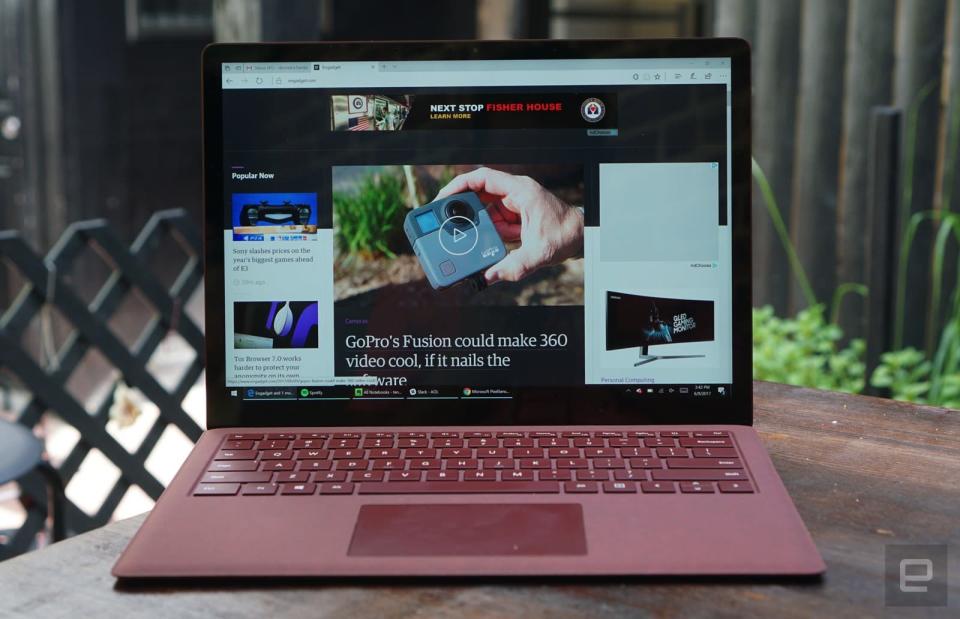
The Surface Laptop continues Microsoft's tradition of packing great displays into its computers. The 13.5-inch screen features a sharp 2,256-by-1,504-pixel resolution, delivering 201 pixels per inch. That's close to what you'd get from Apple's Retina displays, so there aren't any discernible pixels when reading text or viewing images with fine lines. It's a bright and bold screen -- it even looks good outdoors in direct sunlight, though you'd have to contend with a bit of reflectivity.
Since the display features a 3:2 aspect ratio, it's a bit taller than the wide 16:9 screens we see on most laptops (and desktop monitors) today. That's particularly useful for multitasking, since you'll be able to see more information from every window without needing to scroll down. You'll have to live with black bars on the top and bottom of the screen while watching widescreen video, though.
As usual, Microsoft calls the Surface Laptop's screen a "PixelSense" display, its term for all of the multitouch technology it crams in. It's as smooth as the Surface Pro 4 and Surface Book when you use your fingers, and it also supports the company's new Surface Pen. Though you'll have to shell out another $100 to grab that stylus separately, unfortunately.
Software: Windows 10 S
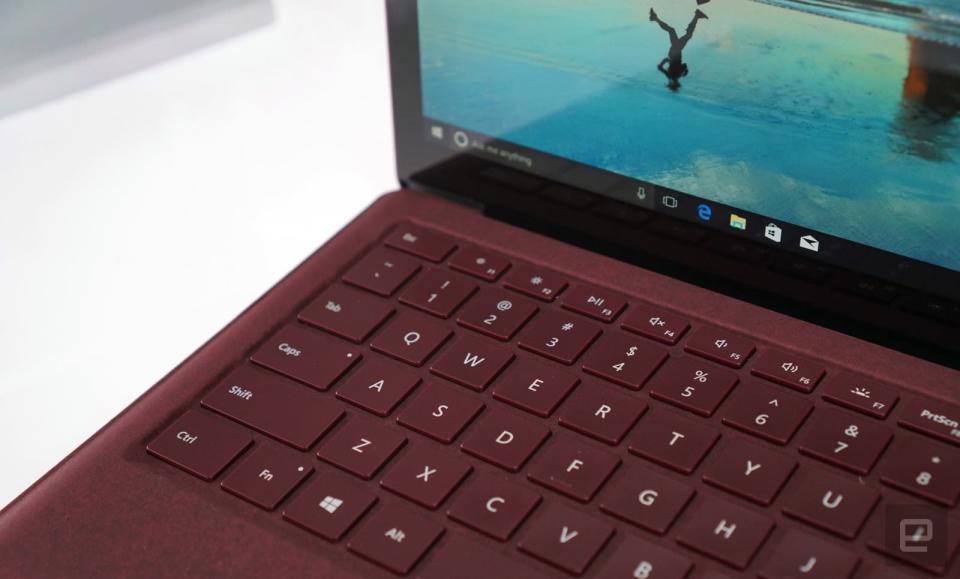
Aside from being Microsoft's most traditional notebook, the Surface Laptop is also the company's flagship Windows 10 S device, its slightly stripped-down OS meant for schools. The major difference it has with normal versions of Windows 10 is that it can run only apps from the Microsoft Store, not legacy apps. Microsoft says this will make it perform better over time, since it won't get bogged down by malware and other potentially dangerous software. Windows Store apps also run in a secured container, so you don't have to worry about them doing anything nefarious to your computer without your knowledge.
For the most part, Windows 10 S made me realize many of the apps I needed, like Evernote and Slack, are already on the Windows Store. That's something Microsoft is hoping to make more users aware of. The fewer people installing random software from the far corners of the web, the better it is for users and Microsoft alike. Getting more eyeballs on the Windows Store is also a useful carrot to lure in developers who have been avoiding it so far. Microsoft also recently announced that more apps, like iTunes and Spotify, are coming to the Store. (Update: Spotify arrived in the Windows Store a week after we published this review.)
I stuck with the Windows 10 S experience for most of this review, and frankly I was surprised by how much I could get done without installing any legacy software. The only real pain was being forced to use Spotify's web player and not having access to any browsers outside of Edge or Internet Explorer. Otherwise, the experience felt identical to the way I typically use my PC. It was a huge difference from Windows RT on the first Surface (Microsoft's first stab at locking out legacy apps), since there's actually a decent app selection now.
If you try to install a legacy app, the OS displays a warning pointing you back to the same app, or something similar, on the Windows Store. You can also choose to upgrade Windows 10 S to Windows 10 Pro through that notification. Currently, the upgrade is free for education customers, users who need assistive features, or for any Windows 10 S device that costs more than $799. Otherwise, it'll cost $49 or under, depending on manufacturer discounts.
As someone who often juggles multiple browsers throughout the day, I eventually outgrew the restrictions in Windows 10 S and chose to upgrade. The process was relatively simple: You get it started from the app store, click through a few dialogue boxes, reboot, and voilà. All in all, it took around five minutes to complete. There's no way to revert back to Windows 10 S, though, without completely reformatting your system.
Performance and battery life
PCMark 7 | PCMark 8 (Creative Accelerated) | 3DMark 11 | 3DMark (Sky Diver) | ATTO (top reads/writes) | |
|---|---|---|---|---|---|
Surface Laptop (Core i5, Intel HD 620) | 5,075 | 4,279 | E2,974 / P1,702 / X429 | 3,630 | 658 MB/s / 238 MB/s |
LG Gram 15.6-inch (2017, 2.7GHz Core i7-7500U, Intel HD 620) | 5,822 | 4,461 | E3,116 / P875 / X247 | 4,062 | 555 MB/s / 520 MB/s |
Dell XPS 13 2-in-1 (1.3GHz Core i7-7Y75, Intel HD 615) | 4,401 | 3,823 | E1,857 / P1,019 / X315 | 2,446 | 1.63 GB/s / 790 MB/s |
Lenovo Yoga 910 (2.7GHz Core i7-7500U, Intel HD 620) | 5,822 | 4,108 | E2,927 / P1,651 / X438 | 3,869 | 1.59 GB/s / 313 MB/s |
HP Spectre x360 (2016, 2.7GHz Core i7-7500U, Intel HD 620) | 5,515 | 4,354 | E2,656 / P1,720 / X444 | 3,743 | 1.76 GB/s / 579 MB/s |
ASUS ZenBook 3 (2.7GHz Intel Core i7-7500U, Intel HD 620) | 5,448 | 3,911 | E2,791 / P1,560 | 3,013 | 1.67 GB/s / 1.44 GB/s |
HP Spectre 13 (2.5GHz Intel Core i7-6500U, Intel HD 520) | 5,046 | 3,747 | E2,790 / P1,630 / X375 | 3,810 | 1.61 GB/s / 307 MB/s |
Dell XPS 13 (2.3GHz Core i5-6200U, Intel Graphics 520) | 4,954 | 3,499 | E2,610 / P1,531 | 3,335 | 1.6GB/s / 307 MB/s |
Microsoft Surface Pro 4 (2.4GHz Core i5-6300U, Intel HD 520) | 5,403 | 3,602 | E2,697/ P1,556/ X422 | 3,614 | 1.6 GB/s / 529 MB/s |
Performance-wise, the Surface Laptop held up to my usual workflow, which involves jumping between dozens of open browser tabs, Evernote, Spotify and photo-editing apps. I never noticed any slowdown on our review unit, which was powered by an Intel Core i5-7200U processor and 8GB of RAM. It performed as well as similarly specced ultraportables on our suite of benchmarks.
Just like the competition, it also handled Minecraft and less demanding games easily, thanks to Intel's HD 620 graphics. Just keep your expectations in check, since there isn't a dedicated graphics card. The only potential issue? The Surface Laptop's disk write speeds are surprisingly low, and both its read and write performance is half as fast as the Surface Pro 4.
Battery life | |
|---|---|
Surface Laptop | 14:49 |
LG Gram 2017 | 10:42 |
Lenovo Yoga 910 | 16:13 |
Apple MacBook Pro 2016 (13-inch, no Touch Bar) | 11:42 |
HP Spectre x360 (13-inch, 2015) | 11:34 |
Apple MacBook Pro 2016 (15-inch) | 11:00 |
HP Spectre x360 15t | 10:17 |
Apple MacBook Pro 2016 (13-inch, Touch Bar) | 9:55 |
ASUS ZenBook 3 | 9:45 |
Apple MacBook (2016) | 8:45 |
Dell XPS 2-in-1 | 8:34 |
Microsoft Surface Pro 4 | 7:15 |
HP Spectre 13 | 7:07 |
Dell XPS 15 (2016) | 5:25 (7:40 with the mobile charger) |
Microsoft claims the Surface Laptop gets around 14.5 hours of battery life while playing video, and our testing came in a bit beyond that, at 14 hours and 40 minutes. It typically had around 40 percent of battery left after using it throughout the workday. Needless to say, it's a huge improvement from the Surface Pro 4, which lasted just 7 hours and 15 minutes. You had to upgrade to the bulkier Surface Book to get decent battery performance from a Microsoft PC up until now.
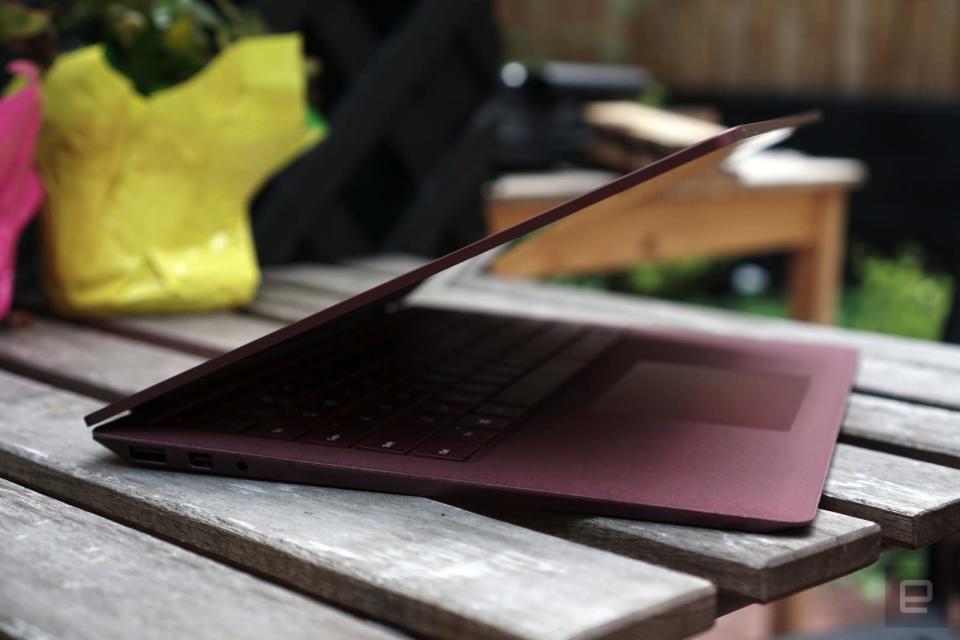
Pricing and the competition
Price-wise, the Surface Laptop is on par with similar ultraportables. It starts at $999 with a Core i5 processor, 4GB of RAM and 128GB of storage. We'd recommend bumping up to the $1,299 model with 8GB of RAM and a 256GB SSD. But if you really want to splurge, you can get a Core i7, with 16GB of RAM and 512GB of storage, for $2,199. For comparison, the Surface Pro starts at $799 with weaker processors, though you can easily spec it up to the same hardware in the Laptop.
As for non-Microsoft notebooks, the Surface Laptop competes directly against Dell's XPS 13 (starting at $899), our go-to Windows ultraportable for the past few years. HP also has a solid contender with its Spectre x360, which also features a screen that can be rotated around to be used as a tablet.
Wrap-up
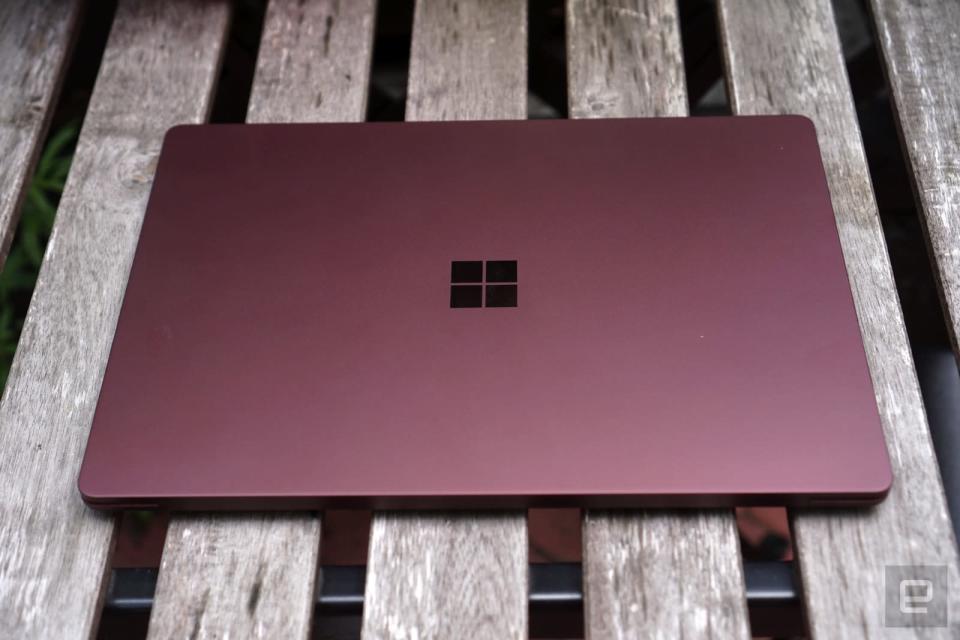
While the Surface Laptop might not seem special on paper, I appreciate how all of Microsoft's design choices came together as I used it. Its metallic case and Alcantara covering beg to be touched; the keyboard didn't slow me down; and its battery life is impressive. It's the sort of laptop that makes you wonder, "Why can't everyone do this?"
Microsoft set out to make the most refined notebook it could with the Surface Laptop, and for the most part it succeeded. It's sleek and powerful and has great battery life. It might seem like a step back for Microsoft, after trying to promote new twists on notebooks over the past few years. But it's more of a realization: There's still a huge demand for traditional laptops. And Microsoft just showed how it's done.










